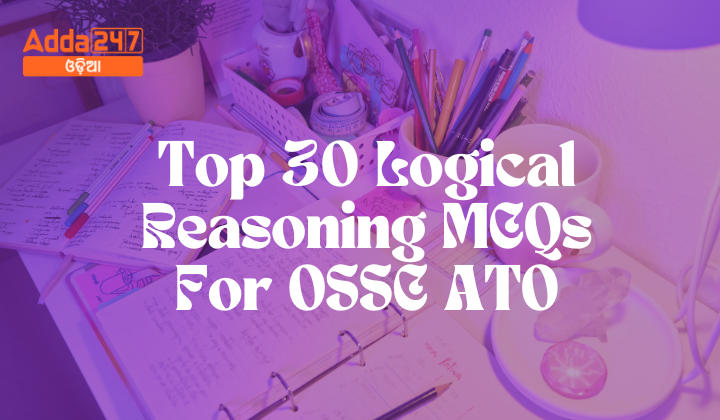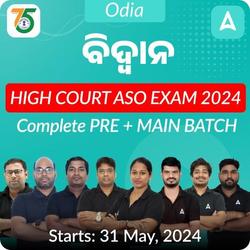Preparing for the Odisha Staff Selection Commission (OSSC) Assistant Training Officer (ATO) exam requires a good grasp of logical reasoning. Here are 30 multiple-choice questions (MCQs) designed to test and enhance your skills in these areas.
Top 30 Logical Reasoning MCQs For OSSC ATO
- Look at this series: 21, 9, 21, 11, 21, 13, 21, … What number should come next?
A) 14
B) 15
C) 21
D) 23
Answer: Option B
Explanation:
In this alternating repetition series, the random number 21 is interpolated every other number into an otherwise simple addition series that increases by 2, beginning with the number 9. - Look at this series: 58, 52, 46, 40, 34, … What number should come next?
A) 26
B) 28
C) 30
D) 32
Answer: Option B
Explanation:
This is a simple subtraction series. Each number is 6 less than the previous number. - Look at this series: 3, 4, 7, 8, 11, 12, … What number should come next?
A) 7
B) 10
C) 14
D) 15
Answer: Option D
Explanation:
This alternating addition series begins with 3; then 1 is added to give 4; then 3 is added to give 7; then 1 is added, and so on. - Look at this series: 8, 22, 8, 28, 8, … What number should come next?
A) 9
B) 29
C) 32
D) 34
Answer: Option D
Explanation:
This is a simple addition series with a random number, 8, interpolated as every other number. In the series, 6 is added to each number except 8, to arrive at the next number. - Look at this series: 31, 29, 24, 22, 17, … What number should come next?
A) 15
B) 14
C) 13
D) 12
Answer: Option A
Explanation:
This is a simple alternating subtraction series, which subtracts 2, then 5. - Look at this series: ZA5, Y4B, XC6, W3D, _____
A) E7V
B) V2E
C) VE5
D) VE7
Answer: Option D
Explanation:
There are three series to look for here. The first letters are alphabetical in reverse: Z, Y, X, W, V. The second letters are in alphabetical order, beginning with A. The number series is as follows: 5, 4, 6, 3, 7. - Look at this series: QPO, NML, KJI, _____, EDC
A) HGF
B) CAB
C) JKL
D) GHI
Answer: Option A
Explanation:
This series consists of letters in a reverse alphabetical order. - Look at this series: JAK, KBL, LCM, MDN, _____
A) OEP
B) NEO
C) MEN
D) PFQ
Answer: Option B
Explanation:
This is an alternating series in alphabetical order. The middle letters follow the order ABCDE. The first and third letters are alphabetical beginning with J. The third letter is repeated as a first letter in each subsequent three-letter segment. - Look at this series: BCB, DED, FGF, HIH, ___
A) JKJ
B) HJH
C) IJI
D) JHJ
Answer: Option A
Explanation:
This series consists of a simple alphabetical order with the first two letters of all segments: B, C, D, E, F, G, H, I, J, K. The third letter of each segment is a repetition of the first letter. - Look at this series: P5QR, P4QS, P3QT, _____, P1QV
A) PQW
B) PQV2
C) P2QU
D) PQ3U
Answer: Option C
Explanation:
The first two letters, PQ, are static. The third letter is in alphabetical order, beginning with R. The number series is in descending order beginning with 5. - Which word does NOT belong with the others?
A) guitar
B) flute
C) violin
D) cello
Answer: Option-B
Explanation: The guitar, violin, and cello are stringed instruments; the flute is a wind instrument. - Which word does NOT belong with the others?
A) dodge
B) flee
C) duck
D) avoid
Answer: Option-B
Explanation: Dodge, duck, and avoid are all synonyms meaning evade. Flee means to run away from. - Which word does NOT belong with the others?
A) branch
B) dirt
C) leaf
D) root
Answer: Option-B
Explanation: A branch, leaf, and root are all parts of a tree. The dirt underneath is not a part of the tree. - Which word does NOT belong with the others?
A) street
B) freeway
C) interstate
D) expressway
Answer: Option-A
Explanation: Freeway, interstate, and expressway are all high-speed highways; a street is for low-speed traffic. - Which word does NOT belong with the others?
A) heading
B) body
C) letter
D) closing
Answer: Option-C
Explanation: Heading, body, and closing are all parts of a letter; the letter is the whole, not a part. - Elated is to despondent as enlightened is to:
A) aware
B) ignorant
C) miserable
D) tolerant
Answer: Option-B
Explanation: Elated is the opposite of despondent; enlightened is the opposite of ignorant. - Optimist is to cheerful as pessimist is to:
A) gloomy
B) mean
C) petty
D) helpful
Answer: Option-A
Explanation: An optimist is a person whose outlook is cheerful. A pessimist is a person whose outlook is gloomy. The answer is not (choice b) because a pessimist does not have to be mean. (Choices c) and d are incorrect because neither adjective describes the outlook of a pessimist. - Reptile is to lizard as flower is to:
A) petal
B) stem
C) daisy
D) alligator
Answer: Option-C
Explanation: A lizard is a type of reptile; a daisy is a type of flower. Choices a and b are incorrect because a petal and a stem are parts of a flower, not types of flowers. (Choice d) is incorrect because an alligator is another type of reptile, not a type of flower. - Play is to actor as concert is to:
A) symphony
B) musician
C) piano
D) percussion
Answer: Option-B
Explanation: An actor performs in a play. A musician performs at a concert. Choices a, c, and d are incorrect because none is people who perform. - Sponge is to porous as rubber is to:
A) massive
B) solid
C) elastic
D) inflexible
Answer: Option-C
Explanation: A sponge is a porous material. Rubber is an elastic material. (Choice a) is incorrect because rubber would not generally be referred to as massive. The answer is not (choice b) because even though rubber is a solid, its most noticeable characteristic is its elasticity. Choice d is incorrect because rubber has flexibility. - Statements: In a one-day cricket match, the total runs made by a team were 200. Out of these, 160 runs were made by spinners.
Conclusions:
80% of the team consists of spinners.
The opening batsmen were spinners.
Options:
A) Only conclusion I follows
B) Only conclusion II follows
C) Either I or II follows
D) Neither I nor II follows
E) Both I and II follow
Answer: D) Neither I nor II follows
Explanation: According to the statement, 80% of the total runs were made by spinners. So, conclusion I does not follow as it talks about team composition, not runs. Nothing about the opening batsmen is mentioned in the statement, so conclusion II does not follow either. - Statements: The old order changed yielding place to new.
Conclusions:
Change is the law of nature.
Discard old ideas because they are old.
Options:
A) Only conclusion I follows
B) Only conclusion II follows
C) Either I or II follows
D) Neither I nor II follows
E) Both I and II follow
Answer: A) Only conclusion I follows
Explanation: Conclusion I directly follows from the given statement. The statement implies that old ideas are replaced by new ones, but it does not state that old ideas should be discarded solely because they are old. - Statements: The government has spoiled many top-ranking financial institutions by appointing bureaucrats as Directors of these institutions.
Conclusions:
Government should appoint Directors of the financial institutes considering the expertise of the person in the area of finance.
The Director of the financial institute should have expertise commensurate with the financial work carried out by the institute.
Options:
A) Only conclusion I follows
B) Only conclusion II follows
C) Either I or II follows
D) Neither I nor II follows
E) Both I and II follow
Answer: E) Both I and II follow
Explanation: The statement indicates that the financial institutions have been spoiled due to the appointment of bureaucrats who likely lack financial expertise. Hence, both conclusions I and II follow, as they both suggest the need for expertise in finance. - Statements: Population increase coupled with depleting resources is going to be the scenario of many developing countries in days to come.
Conclusions:
The population of developing countries will not continue to increase in the future.
It will be very difficult for the governments of developing countries to provide their people with a decent quality of life.
Options:
A) Only conclusion I follows
B) Only conclusion II follows
C) Either I or II follows
D) Neither I nor II follows
E) Both I and II follow
Answer: B) Only conclusion II follows
Explanation: Conclusion I is contrary to the given statement. Conclusion II follows because the statement indicates that increasing population and depleting resources will make it difficult to maintain a decent quality of life. - Statements: Prime age school-going children in urban India have now become avid as well as more regular viewers of television, even in households without a TV. As a result, there has been an alarming decline in the extent of readership of newspapers.
Conclusions:
Method of increasing the readership of newspapers should be devised.
A team of experts should be sent to other countries to study the impact of TV on the readership of newspapers.
Options:
A) Only conclusion I follows
B) Only conclusion II follows
C) Either I or II follows
D) Neither I nor II follows
E) Both I and II follow
Answer: D) Neither I nor II follows
Explanation: The statement focuses on the increasing viewership of TV and the decline in newspaper readership but does not imply that methods to increase newspaper readership should be devised or that a study should be conducted. - CUP : LIP :: BIRD : ?
A) BUSH
B) GRASS
C) FOREST
D) BEAK
Answer: D) BEAK
Explanation: A cup is used to drink something with the help of lips. Similarly, a bird collects materials like grass with the help of its beak. - Flow : River :: Stagnant : ?
A) Rain
B) Stream
C) Pool
D) Canal
Answer: C) Pool
Explanation: As water in a river flows, similarly, water in a pool is stagnant. - Paw : Cat :: Hoof : ?
A) Lamb
B) Elephant
C) Lion
D) Horse
Answer: D) Horse
Explanation: Just as a cat has paws, a horse has hooves. - Ornithologist : Bird :: Archaeologist : ?
A) Islands
B) Mediators
C) Archaeology
D) Aquatic
Answer: C) Archaeology
Explanation: An ornithologist is a specialist in birds, similarly, an archaeologist is a specialist in archaeology. - Peacock : India :: Bear : ?
A) Australia
B) America
C) Russia
D) England
Answer: C) Russia
Explanation: As the peacock is the national bird of India, the bear is the national animal of Russia.
















